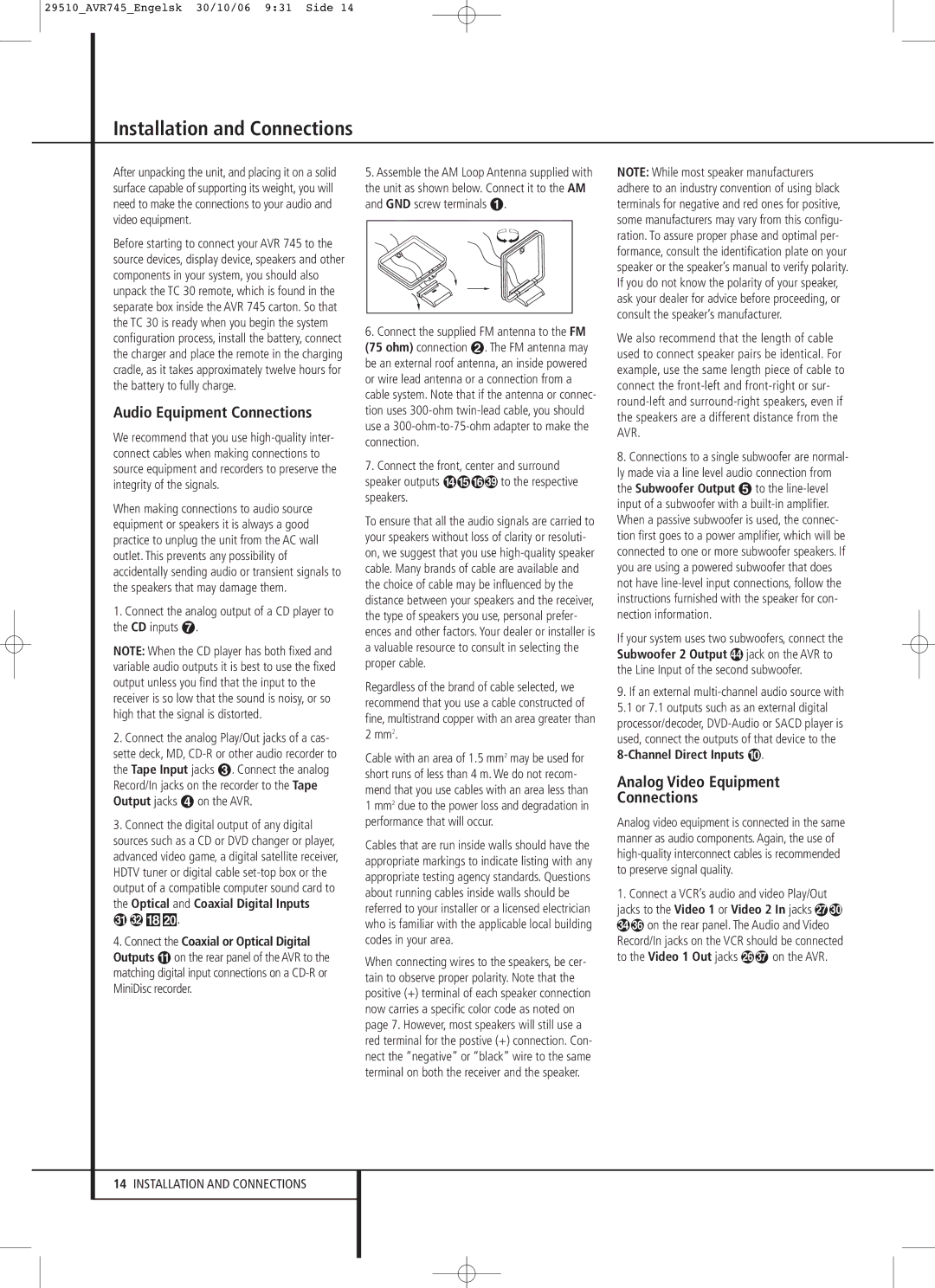
29510_AVR745_Engelsk 30/10/06 9:31 Side 14
Installation and Connections
After unpacking the unit, and placing it on a solid surface capable of supporting its weight, you will need to make the connections to your audio and video equipment.
Before starting to connect your AVR 745 to the source devices, display device, speakers and other components in your system, you should also unpack the TC 30 remote, which is found in the separate box inside the AVR 745 carton. So that the TC 30 is ready when you begin the system configuration process, install the battery, connect the charger and place the remote in the charging cradle, as it takes approximately twelve hours for the battery to fully charge.
Audio Equipment Connections
We recommend that you use
When making connections to audio source equipment or speakers it is always a good practice to unplug the unit from the AC wall outlet. This prevents any possibility of accidentally sending audio or transient signals to the speakers that may damage them.
1. Connect the analog output of a CD player to the CD inputs .
NOTE: When the CD player has both fixed and variable audio outputs it is best to use the fixed output unless you find that the input to the receiver is so low that the sound is noisy, or so high that the signal is distorted.
2.Connect the analog Play/Out jacks of a cas- sette deck, MD,
the Tape Input jacks . Connect the analog Record/In jacks on the recorder to the Tape
Output jacks | on the AVR. |
3.Connect the digital output of any digital sources such as a CD or DVD changer or player, advanced video game, a digital satellite receiver, HDTV tuner or digital cable
* Ó.
4.Connect the Coaxial or Optical Digital Outputs on the rear panel of the AVR to the matching digital input connections on a
5.Assemble the AM Loop Antenna supplied with the unit as shown below. Connect it to the AM
and GND screw terminals .
6. Connect the supplied FM antenna to the FM
(75 ohm) connection . The FM antenna may be an external roof antenna, an inside powered or wire lead antenna or a connection from a cable system. Note that if the antenna or connec- tion uses
7. Connect the front, center and surround
speaker outputsto the respective speakers.
To ensure that all the audio signals are carried to your speakers without loss of clarity or resoluti- on, we suggest that you use
Regardless of the brand of cable selected, we recommend that you use a cable constructed of fine, multistrand copper with an area greater than 2 mm2.
Cable with an area of 1.5 mm2 may be used for short runs of less than 4 m. We do not recom- mend that you use cables with an area less than 1 mm2 due to the power loss and degradation in performance that will occur.
Cables that are run inside walls should have the appropriate markings to indicate listing with any appropriate testing agency standards. Questions about running cables inside walls should be referred to your installer or a licensed electrician who is familiar with the applicable local building codes in your area.
When connecting wires to the speakers, be cer- tain to observe proper polarity. Note that the positive (+) terminal of each speaker connection now carries a specific color code as noted on page 7. However, most speakers will still use a red terminal for the postive (+) connection. Con- nect the “negative” or “black” wire to the same terminal on both the receiver and the speaker.
NOTE: While most speaker manufacturers adhere to an industry convention of using black terminals for negative and red ones for positive, some manufacturers may vary from this configu- ration. To assure proper phase and optimal per- formance, consult the identification plate on your speaker or the speaker’s manual to verify polarity. If you do not know the polarity of your speaker, ask your dealer for advice before proceeding, or consult the speaker’s manufacturer.
We also recommend that the length of cable used to connect speaker pairs be identical. For example, use the same length piece of cable to connect the
8.Connections to a single subwoofer are normal- ly made via a line level audio connection from
the Subwoofer Output to the
If your system uses two subwoofers, connect the Subwoofer 2 Output jack on the AVR to the Line Input of the second subwoofer.
9.If an external
8-Channel Direct Inputs .
Analog Video Equipment
Connections
Analog video equipment is connected in the same manner as audio components. Again, the use of
1.Connect a VCR’s audio and video Play/Out jacks to the Video 1 or Video 2 In jacks
on the rear panel. The Audio and Video Record/In jacks on the VCR should be connected
to the Video 1 Out jacks | on the AVR. |
14INSTALLATION AND CONNECTIONS
